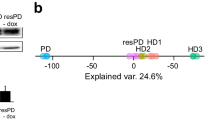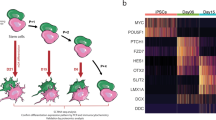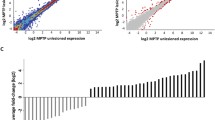Abstract
Dopaminergic (DA) neuron degeneration is a feature of brain aging but is markedly increased in patients with Parkinson’s disease (PD). Recent data indicate elevated metabolic stress as a possible explanation for DA neuron vulnerability. Using laser capture microdissection, we isolated DA neurons from the substantia nigra pars compacta of PD patients, age-matched and young controls to determine transcriptional changes by expression profiling and pathway analysis. We verified our findings by comparison to a published dataset. Parallel processing of isolated neurons and bulk tissue allowed the discrimination of neuronal and glial transcription signals. Our data show that genes known to be involved in neural plasticity, axon and synaptic function, as well as cell fate are differentially regulated in aging DA neurons. The transcription patterns in aging suggest a largely maintained expression of genes in energy-related pathways in surviving neurons, possibly supported by the mediation of PPAR/RAR and CREB signaling. In contrast, a profound down-regulation of genes coding for mitochondrial and ubiquitin–proteasome system proteins was seen in PD when compared to the age-matched controls. This is in accordance with the established mitochondrial dysfunction in PD and provides evidence for mitochondrial impairment at the transcriptional level. In addition, the PD neurons had disrupted pathways that comprise a network involved in the control of energy metabolism and cell survival in response to growth factors, oxidative stress, and nutrient deprivation (PI3K/Akt, mTOR, eIF4/p70S6K and Hif-1α). PI3K/Akt and mTOR signaling are central hubs of this network which is of relevance to longevity and—together with induction of mitochondrial biogenesis—may constitute potential targets for therapeutic intervention.





Similar content being viewed by others
References
Abou-Sleiman PM, Muqit MM, Wood NW (2006) Expanding insights of mitochondrial dysfunction in Parkinson’s disease. Nat Rev Neurosci 7:207–219
Aleyasin H, Rousseaux MW, Marcogliese PC et al (2010) DJ-1 protects the nigrostriatal axis from the neurotoxin MPTP by modulation of the AKT pathway. Proc Natl Acad Sci USA 107:3186–3191
Altar CA, Vawter MP, Ginsberg SD (2009) Target identification for CNS diseases by transcriptional profiling. Neuropsychopharmacology 34:18–54
Atz M, Walsh D, Cartagena P et al (2007) Methodological considerations for gene expression profiling of human brain. J Neurosci Methods 163:295–309
Benard G, Bellance N, Jose C, Melser S, Nouette-Gaulain K, Rossignol R (2010) Multi-site control and regulation of mitochondrial energy production. Biochim Biophys Acta 1797:698–709
Bender A, Krishnan KJ, Morris CM et al (2006) High levels of mitochondrial DNA deletions in substantia nigra neurons in aging and Parkinson disease. Nat Genet 38:515–517
Bender A, Schwarzkopf RM, McMillan A et al (2008) Dopaminergic midbrain neurons are the prime target for mitochondrial DNA deletions. J Neurol 255:1231–1235
Betarbet R, Canet-Aviles RM, Sherer TB et al (2006) Intersecting pathways to neurodegeneration in Parkinson’s disease: effects of the pesticide rotenone on DJ-1, alpha-synuclein, and the ubiquitin-proteasome system. Neurobiol Dis 22:404–420
Bishop NA, Lu T, Yankner BA (2010) Neural mechanisms of ageing and cognitive decline. Nature 464:529–535
Bossers K, Meerhoff G, Balesar R et al (2009) Analysis of gene expression in Parkinson’s disease: possible involvement of neurotrophic support and axon guidance in dopaminergic cell death. Brain Pathol 19:91–107
Braak H, Del Tredici K, Rüb U, de Vos RA, Jansen Steur EN, Braak E (2003) Staging of brain pathology related to sporadic Parkinson’s disease. Neurobiol Aging 24:197–211
Buesa C, Maes T, Subirada F, Barrachina M, Ferrer I (2004) DNA chip technology in brain banks: confronting a degrading world. J Neuropathol Exp Neurol 63:1003–1014
Cabello CR, Thune JJ, Pakkenberg H, Pakkenberg B (2002) Ageing of substantia nigra in humans: cell loss may be compensated by hypertrophy. Neuropathol Appl Neurobiol 28:283–291
Calvano SE, Xiao W, Richards DR et al (2005) A network-based analysis of systemic inflammation in humans. Nature 437:1032–1037
Cantuti-Castelvetri I, Keller-McGandy C, Bouzou B et al (2007) Effects of gender on nigral gene expression and Parkinson disease. Neurobiol Dis 26:606–614
Chan CS, Guzman JN, Ilijic E et al (2007) ‘Rejuvenation’ protects neurons in mouse models of Parkinson’s disease. Nature 447:1081–1086
Croisier E, Graeber MB (2006) Glial degeneration and reactive gliosis in alpha-synucleinopathies: the emerging concept of primary gliodegeneration. Acta Neuropathol 112:517–530
Dauer W, Przedborski S (2003) Parkinson’s disease: mechanisms and models. Neuron 39:889–909
Domingues AF, Arduíno DM, Esteves AR, Swerdlow RH, Oliveira CR, Cardoso SM (2008) Mitochondria and ubiquitin-proteasomal system interplay: relevance to Parkinson’s disease. Free Radic Biol Med 45:820–825
Duke DC, Moran LB, Kalaitzakis ME et al (2006) Transcriptome analysis reveals link between proteasomal and mitochondrial pathways in Parkinson’s disease. Neurogenetics 7:139–148
Elbaz A, Moisan F (2008) Update in the epidemiology of Parkinson’s disease. Curr Opin Neurol 21:454–460
Elstner M, Andreoli C, Klopstock T, Meitinger T, Prokisch H (2009) The mitochondrial proteome database: MitoP2. Methods Enzymol 457:3–20
Elstner M, Morris CM, Heim K et al (2009) Single-cell expression profiling of dopaminergic neurons combined with association analysis identifies pyridoxal kinase as Parkinson’s disease gene. Ann Neurol 66:792–798
Farrer MJ (2006) Genetics of Parkinson disease: paradigm shifts and future prospects. Nat Rev Genet 7:306–318
Fearnley JM, Lees AJ (1991) Ageing and Parkinson’s disease: substantia nigra regional selectivity. Brain 114:2283–2301
Fujino T, Kondo J, Ishikawa M, Morikawa K, Yamamoto TT (2001) Acetyl-CoA synthetase 2, a mitochondrial matrix enzyme involved in the oxidation of acetate. J Biol Chem 276:11420–11426
Gagne JJ, Power MC (2010) Anti-inflammatory drugs and risk of Parkinson disease: a meta-analysis. Neurology 74:995–1002
Gasser T (2009) Molecular pathogenesis of Parkinson disease: insights from genetic studies. Expert Rev Mol Med 11:e22
Geisler S, Holmström KM, Skujat D et al (2010) PINK1/Parkin-mediated mitophagy is dependent on VDAC1 and p62/SQSTM1. Nat Cell Biol 12:119–131
Gerlach M, Double KL, Youdim MB, Riederer P (2000) Strategies for the protection of dopaminergic neurons against neurotoxicity. Neurotox Res 2:99–114
Graeber MB (2008) Twenty-first century brain banking: at the crossroads. Acta Neuropathol 115:493–496
Grunblatt E, Mandel S, Jacob-Hirsch J et al (2004) Gene expression profiling of parkinsonian substantia nigra pars compacta; alterations in ubiquitin-proteasome, heat shock protein, iron and oxidative stress regulated proteins, cell adhesion/cellular matrix and vesicle trafficking genes. J Neural Transm 111:1543–1573
Guzman JN, Sanchez-Padilla J, Wokosin D et al (2010) Oxidant stress evoked by pacemaking in dopaminergic neurons is attenuated by DJ-1. Nature 468:696–700
Hauser MA, Li YJ, Xu H et al (2005) Expression profiling of substantia nigra in Parkinson disease, progressive supranuclear palsy, and frontotemporal dementia with parkinsonism. Arch Neurol 62:917–921
Hock MB, Kralli A (2009) Transcriptional control of mitochondrial biogenesis and function. Annu Rev Physiol 71:177–203
Klinge CM (2008) Estrogenic control of mitochondrial function and biogenesis. J Cell Biochem 105:1342–1351
Lee DW, Rajagopalan S, Siddiq A et al (2009) Inhibition of prolyl hydroxylase protects against 1-methyl-4-phenyl-1, 2, 3, 6-tetrahydropyridine-induced neurotoxicity: model for the potential involvement of the hypoxia-inducible factor pathway in Parkinson disease. J Biol Chem 284:29065–29076
Lesnick TG, Papapetropoulos S, Mash DC et al (2007) A genomic pathway approach to a complex disease: axon guidance and Parkinson disease. PLoS Genet 3:e98
López-Lluch G, Irusta PM, Navas P, de Cabo R (2008) Mitochondrial biogenesis and healthy aging. Exp Gerontol 43:813–819
Lu T, Pan Y, Kao SY et al (2004) Gene regulation and DNA damage in the ageing human brain. Nature 429:883–891
Malagelada C, Jin ZH, Jackson-Lewis V, Przedborski S, Greene LA (2010) Rapamycin protects against neuron death in in vitro and in vivo models of Parkinson’s disease. J Neurosci 30:1166–1175
McKeith IG, Dickson DW, Lowe J et al (2005) Diagnosis and management of dementia with Lewy bodies: third report of the DLB Consortium. Neurology 65:1863–1872
Miller RM, Kiser GL, Kaysser-Kranich TM, Lockner RJ, Palaniappan C, Federoff HJ (2006) Robust dysregulation of gene expression in substantia nigra and striatum in Parkinson’s disease. Neurobiol Dis 21:305–313
Mirnics K, Pevsner J (2004) Progress in the use of microarray technology to study the neurobiology of disease. Nat Neurosci 7:434–439
Moran LB, Duke DC, Deprez M, Dexter DT, Pearce RK, Graeber MB (2006) Whole genome expression profiling of the medial and lateral substantia nigra in Parkinson’s disease. Neurogenetics 7:1–11
Moran LB, Graeber MB (2008) Towards a pathway definition of Parkinson’s disease: a complex disorder with links to cancer, diabetes and inflammation. Neurogenetics 9:1–13
Nakaso K, Ito S, Nakashima K (2008) Caffeine activates the PI3K/Akt pathway and prevents apoptotic cell death in a Parkinson’s disease model of SH-SY5Y cells. Neurosci Lett 432:146–150
Narendra DP, Jin SM, Tanaka A et al (2010) PINK1 is selectively stabilized on impaired mitochondria to activate Parkin. PLoS Biol 8:e1000298
Nedelsky NB, Todd PK, Taylor JP (2008) Autophagy and the ubiquitin-proteasome system: collaborators in neuroprotection. Biochim Biophys Acta 1782:691–699
Pan T, Kondo S, Zhu W, Xie W, Jankovic J, Le W (2008) Neuroprotection of rapamycin in lactacystin-induced neurodegeneration via autophagy enhancement. Neurobiol Dis 32:16–25
Riederer P, Youdim MB, Mandel S, Gerlach M, Grünblatt E (2008) Genomic aspects of sporadic Parkinson’s disease. Parkinsonism Relat Disord 14:S88–S91
Rollo CD (2009) Dopamine and aging: intersecting facets. Neurochem Res 34:601–629
Ross GW, Petrovitch H, Abbott RD et al (2004) Parkinsonian signs and substantia nigra neuron density in decendents elders without PD. Ann Neurol 56:532–539
Rudow G, O’Brien R, Savonenko AV et al (2008) Morphometry of the human substantia nigra in ageing and Parkinson’s disease. Acta Neuropathol 115:461–470
Sekoguchi E, Sato N, Yasui A et al (2003) A novel mitochondrial carnitine-acylcarnitine translocase induced by partial hepatectomy and fasting. J Biol Chem 278:38796–38802
Simunovic F, Yi M, Wang Y et al (2008) Gene expression profiling of substantia nigra dopamine neurons: further insights into Parkinson’s disease pathology. Brain 132:1795–1809
Simunovic F, Yi M, Wang Y, Stephens R, Sonntag KC (2010) Evidence for gender-specific transcriptional profiles of nigral dopamine neurons in Parkinson disease. PLoS One 5:e8856
Stark AK, Pakkenberg B (2004) Histological changes of the dopaminergic nigrostriatal system in aging. Cell Tissue Res 318:81–92
Surmeier DJ (2007) Calcium, ageing, and neuronal vulnerability in Parkinson’s disease. Lancet Neurol 6:933–938
Sutherland GT, Matigian NA, Chalk AM et al (2009) A cross-study transcriptional analysis of Parkinson’s disease. PLoS One 4:e4955
Tain LS, Mortiboys H, Tao RN, Ziviani E, Bandmann O, Whitworth AJ (2009) Rapamycin activation of 4E-BP prevents parkinsonian dopaminergic neuron loss. Nat Neurosci 12:1129–1135
Timmons S, Coakley MF, Moloney AM, O’ Neill C (2009) Akt signal transduction dysfunction in Parkinson’s disease. Neurosci Lett 467:30–35
Vanitallie TB (2008) Parkinson disease: primacy of age as a risk factor for mitochondrial dysfunction. Metabolism 57(Suppl 2):S50–S55
Vasseur S, Afzal S, Tardivel-Lacombe J, Park DS, Iovanna JL, Mak TW (2009) DJ-1/PARK7 is an important mediator of hypoxia-induced cellular responses. Proc Natl Acad Sci USA 106:1111–1116
Vawter MP, Tomita H, Meng F et al (2006) Mitochondrial-related gene expression changes are sensitive to agonal-pH state: implications for brain disorders. Mol Psychiatry 11:663–679
Vogt IR, Lees AJ, Evert BO, Klockgether T, Bonin M, Wüllner U (2006) Transcriptional changes in multiple system atrophy and Parkinson’s disease putamen. Exp Neurol 199:465–478
Wright DC, Geiger PC, Han DH, Jones TE, Holloszy JO (2007) Calcium induces increases in peroxisome proliferator-activated receptor gamma coactivator-1 alpha and mitochondrial biogenesis by a pathway leading to p38 mitogen-activated protein kinase activation. J Biol Chem 282:18793–18799
Zhang Y, James M, Middleton FA, Davis RL (2005) Transcriptional analysis of multiple brain regions in Parkinson’s disease supports the involvement of specific protein processing, energy metabolism, and signaling pathways, and suggests novel disease mechanisms. Am J Med Genet B Neuropsychiatr Genet 137:5–16
Zheng B, Liao Z, Locascio JJ, et al (2010) PGC-1α, a potential therapeutic target for early intervention in Parkinson’s disease. Sci Transl Med 2:52ra73
Acknowledgments
The European Neurological Society funded M.E.; T.K., T.M., and H.P. are members of the German Network for Mitochondrial Disorders (mitoNET, 01GM0862 and 01GM0867); T.M. and H.P. were supported by the Impulse and Networking Fund of the Helmholtz Association in the framework of the Helmholtz Alliance for Mental Health in an Ageing Society (HA-215), the German Federal Ministry of Education and Research (BMBF) funded German National Research Network (NGFNplus #01GS08134) and Systems Biology of Metabotypes (SysMBo #0315494A). CMM gratefully acknowledges funding from the Health Protection Agency UK. Tissue for this study was provided by the Newcastle Brain Tissue Resource, which is funded in part by a grant from the UK Medical Research Council (G0400074), by the Newcastle NIHR Biomedical Research Centre in Ageing and Age Related Diseases awarded to the Newcastle upon Tyne Hospitals NHS Foundation Trust, and by a grant as part of the Brains for Dementia Research initiative funded by the Alzheimer’s Research Trust and the Alzheimer’s Society.
Author information
Authors and Affiliations
Corresponding author
Electronic supplementary material
Below is the link to the electronic supplementary material.
Rights and permissions
About this article
Cite this article
Elstner, M., Morris, C.M., Heim, K. et al. Expression analysis of dopaminergic neurons in Parkinson’s disease and aging links transcriptional dysregulation of energy metabolism to cell death. Acta Neuropathol 122, 75–86 (2011). https://doi.org/10.1007/s00401-011-0828-9
Received:
Revised:
Accepted:
Published:
Issue Date:
DOI: https://doi.org/10.1007/s00401-011-0828-9




